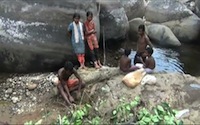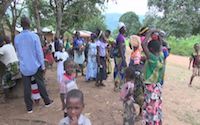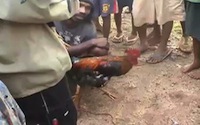The Mocoví language (moqoit la’qaatqa) belongs to the Guaycuruan linguistic family, which also includes the Toba, Pilaga, and Kadiweu languages. In addition, the now extinct languages Abipon, and possibly Mbaya-Payagua and Guachi have been attributed to this family (cf. Loukotka 1968, Tovar y Tovar 1984, Greenberg 1987).
The socio-linguistic situation among the Mocoví is far from homogenous. In general terms, we can determine two large areas: the southern part of the province of the Chaco, with a greater linguistic and cultural preservation; and the province of Santa Fe, where the Mocoví people have experienced a serious process of language loss since the 1950s. In Santa Fe, our research area, there was a rupture in language transmission to children and currently only some adults and the elderly, especially the women, still use their native language.
From the linguistic perspective, there are differences between these two areas. Even among the speakers themselves, the phonological isogloss that with greater clarity distinguishes these two regional varieties is the palatalization of coronal segments, which operates regularly and extensively in the Chaco Mocoví and in restricted contexts in the Santa Fe variety. (Click here for more info)
The structure of the word in Mocoví is morphologically complex with polysynthetic features. The grammatical relationships are coded in the verbal/nominal nucleus through the pronominal morphology and/or other specific markers. The expression of semantic roles in the pronominal morphology, in terms of the affect of the participants allow us to characterize Mocoví as a language with an Active/Inactive case system (cf. Gualdieri 1998).
The order of the syntactic constituents is relatively free, with greater frequency of SVO in transitive clauses, VS in the intransitive ones, and NA in the nominal phrase.
A characteristic feature of the Guaycuruan languages, and therefore of Mocoví, is the recurring grammatical expression of spatial parameters. On the one hand, there exists a closed system of six elements that generally accompany the nouns and that codifies semantic configurational and deictic parameters. This system is characterized by having properties of nominal classifiers and demonstratives, and by entering into morphological processes deriving another lexical categories (cf. Grinevald 2000). On the other hand, distinctions linked with location and direction are also grammaticalized in the verbal morphology (cf. Gualdieri 2000).
References
Greenberg, Joseph (1987). Language in the Americas. Stanford: Stanford University.
Grinevald, Colette (2000). A morphosyntactic typology of classifiers. In G. Senft (ed.), Systems of Nominal Classification, 50-92. Cambridge: Cambridge University Press.
Gualdieri, Cecilia Beatriz (1998). Mocoví (Guaicuru). Fonologia e morfossintaxe. PhD Thesis. Universidade Estadual de Campinas.
Gualdieri, Beatriz (2000). Las relaciones espaciales en mocoví (Guaycurú). In L. Miranda (ed.), Actas del Primer Congreso de Lenguas Indígenas de Sudamérica, Vol I, 279-293. Lima, Perú: Universidad Ricardo Palma, Facultad de Lenguas Modernas, Departamento Académico de Humanidades.
Loukotka, Cestmir (1968). Classification of South American Indian Languages. Los Angeles: Latin American Center, University of California.
Tovar, Antonio and Larrucea de Tovar, Consuelo (1984). Catálogo de las lenguas de América del Sur. Madrid: Gredos.







